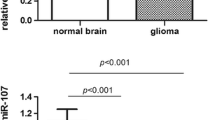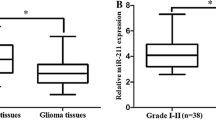Abstract
Objective
MicroRNA-224 (miR-224) has been consistently reported to be dysregulated in various human malignancies and can potentially affect many cancer-related cellular processes, including transcription, cell differentiation, cell death, growth, and cell proliferation. However, its roles in human glioma have not been reported. The aim of this study was to explore the expression pattern, clinical significance, and prognostic value of miR-224 in glioma patients using large cohorts.
Methods
Quantitative real-time polymerase chain reaction analysis was used to characterize the expression patterns of miR-224 in 108 glioma and 20 normal brain tissues. The associations of miR-224 expression with clinicopathological factors and prognosis of glioma patients were also statistically analyzed.
Results
miR-224 expression is significantly upregulated in glioma tissues compared with normal brain tissues (P < 0.001). In addition, high expression of miR-224 was significantly associated with advanced pathological grade (P = 0.006) and low Karnofsky performance score (KPS, P = 0.01). Moreover, Kaplan–Meier survival analysis showed that high miR-224 expression group had significantly shorter disease-free survival (DFS) and overall survival (OS) rates than low miR-224 expression group (both P < 0.001). Multivariate analysis with the Cox’s proportional hazards model revealed that high expression of miR-224 (P = 0.006 and P = 0.01, respectively) and advanced pathological grade (both P = 0.02) were independent factors for shorter DFS and OS. Furthermore, subgroup analyses showed that miR-224 expression was significantly associated with poor DFS and OS in glioma patients with high pathological grades (for grade III–IV: P < 0.001 and P = 0.005, respectively).
Conclusions
MiR-224 is upregulated and confers a poor prognosis in glioma patients.


Similar content being viewed by others
References
Rousseau A, Mokhtari K, Duyckaerts C (2007) The 2007 WHO classification of tumors of the central nervous system-what has changed? Curr Opin Neurol 21:720–727
Brandes AA (2003) State-of-the-art treatment of high-grade brain tumors. Semin Oncol 30:4–9
Ohgaki H, Kleihues P (2005) Epidemiology and etiology of gliomas. Acta Neuropathol 109:93–108
Hutterer M, Knyazev P, Abate A (2008) Axl and growth arrest-specific gene 6 are frequently overexpressed in human gliomas and predict poor prognosis in patients with glioblastoma multiforme. Clin Cancer Res 14:130–138
Visone R, Croce CM (2009) MiRNAs and cancer. Am J Pathol 174:1131–1138
Liu A, Xu X (2011) MicroRNA isolation from formalin-fixed, paraffin embedded tissues. Methods Mol Biol 724:259–267
Chan XH, Nama S, Gopal F, Rizk P, Ramasamy S, Sundaram G, Ow GS, Vladimirovna IA, Tanavde V, Haybaeck J, Kuznetsov V, Sampath P (2012) Targeting glioma stem cells by functional inhibition of a prosurvival OncomiR-138 in malignant gliomas. Cell Rep 2:591–602
Papagiannakopoulos T, Shapiro A, Kosik KS (2008) MicroRNA-21 targets a network of key tumor-suppressive pathways in glioblastoma cells. Cancer Res 68:8164–8172
Godlewski J, Nowicki MO, Bronisz A, Williams S, Otsuki A, Nuovo G, Raychaudhury A, Newton HB, Chiocca EA, Lawler S (2008) Targeting of the Bmi-1 oncogene/stem cell renewal factor by microRNA-128 inhibits glioma proliferation and self-renewal. Cancer Res 68:9125–9130
Sasayama T, Nishihara M, Kondoh T, Hosoda K, Kohmura E (2009) MicroRNA-10b is overexpressed in malignant glioma and associated with tumor invasive factors, uPAR and RhoC. Int J Cancer 125:1407–1413
Guan Y, Mizoguchi M, Yoshimoto K, Hata N, Shono T, Suzuki SO, Araki Y, Kuga D, Nakamizo A, Amano T, Ma X, Hayashi K, Sasaki T (2010) MiRNA-196 is upregulated in glioblastoma but not in anaplastic astrocytoma and has prognostic significance. Clin Cancer Res 16:4289–4297
Verhaak RG, Hoadley KA, Purdom E, Wang V, Qi Y, Wilkerson MD, Miller CR, Ding L, Golub T, Mesirov JP, Alexe G, Lawrence M, O’Kelly M, Tamayo P, Weir BA, Gabriel S, Winckler W, Gupta S, Jakkula L, Feiler HS, Hodgson JG, James CD, Sarkaria JN, Brennan C, Kahn A, Spellman PT, Wilson RK, Speed TP, Gray JW, Meyerson M, Getz G, Perou CM, Hayes DN, Cancer Genome Atlas Research Network (2010) Integrated genomic analysis identifies clinically relevant subtypes of glioblastoma characterized by abnormalities in PDGFRA, IDH1, EGFR, and NF1. Cancer Cell 17(1):98–110
Altuvia Y, Landgraf P, Lithwick G, Elefant N, Pfeffer S, Aravin A, Brownstein MJ, Tuschl T, Margalit H (2005) Clustering and conservation patterns of human microRNAs. Nucleic Acids Res 33:2697–2706
Landgraf P, Rusu M, Sheridan R, Sewer A, Iovino N, Aravin A, Pfeffer S, Rice A, Kamphorst AO, Landthaler M, Lin C, Socci ND, Hermida L, Fulci V, Chiaretti S, Foa R, Schliwka J, Fuchs U, Novosel A, Muller RU, Schermer B, Bissels U, Inman J, Phan Q, Chien M (2007) A mammalian microRNA expression atlas based on small RNA library sequencing. Cell 129:1401–1414
Wang Y, Lee CG (2011) Role of miR-224 in hepatocellular carcinoma: a tool for possible therapeutic intervention? Epigenomics 3:235–243
Fu J, Tang W, Du P, Wang G, Chen W, Li J, Zhu Y, Gao J, Cui L (2012) Identifying microRNA-mRNA regulatory network in colorectal cancer by a combination of expression profile and bioinformatics analysis. BMC Syst Biol 6:68
Gokhale A, Kunder R, Goel A, Sarin R, Moiyadi A, Shenoy A, Mamidipally C, Noronha S, Kannan S, Shirsat NV (2010) Distinctive microRNA signature of medulloblastomas associated with the WNT signaling pathway. J Cancer Res Ther 6:521–529
Pai R, Nehru GA, Samuel P, Selvan B, Kumar R, Jacob PM, Nair A (2012) Discriminating thyroid cancers from benign lesions based on differential expression of a limited set of miRNA using paraffin embedded tissues. Indian J Pathol Microbiol 55:158–162
Mees ST, Mardin WA, Sielker S, Willscher E, Senninger N, Schleicher C, Colombo-Benkmann M, Haier J (2009) Involvement of CD40 targeting miR-224 and miR-486 on the progression of pancreatic ductal adenocarcinomas. Ann Surg Oncol 16:2339–2350
Prueitt RL, Yi M, Hudson RS, Wallace TA, Howe TM, Yfantis HG, Lee DH, Stephens RM, Liu CG, Calin GA, Croce CM, Ambs S (2008) Expression of microRNAs and protein-coding genes associated with perineural invasion in prostate cancer. Prostate 68:1152–1164
Lichner Z, Mejia-Guerrero S, Ignacak M, Krizova A, Bao TT, Girgis AH, Youssef YM, Yousef GM (2012) Pleiotropic action of renal cell carcinoma-dysregulated miRNAs on hypoxia-related signaling pathways. Am J Pathol 180:1675–1687
Christenson LK (2010) MicroRNA control of ovarian function. Anim Reprod 7:129–133
Scapoli L, Palmieri A, Lo Muzio L, Pezzetti F, Rubini C, Girardi A, Farinella F, Mazzotta M, Carinci F (2010) MicroRNA expression profiling of oral carcinoma identifies new markers of tumor progression. Int J Immunopathol Pharmacol 23:1229–1234
Wang Y, Lee AT, Ma JZ, Wang J, Ren J, Yang Y, Tantoso E, Li KB, Ooi LL, Tan P, Lee CG (2008) Profiling microRNA expression in hepatocellular carcinoma reveals microRNA-224 up-regulation and apoptosis inhibitor-5 as a microRNA-224-specific target. J Biol Chem 283:13205–13215
Gilad S, Meiri E, Yogev Y, Benjamin S, Lebanony D, Yerushalmi N, Benjamin H, Kushnir M, Cholakh H, Melamed N, Bentwich Z, Hod M, Goren Y, Chajut A (2008) Serum microRNAs are promising novel biomarkers. PLoS ONE 3:e3148
Li X, Shen Y, Ichikawa H, Antes T, Goldberg GS (2009) Regulation of miRNA expression by Src and contact normalization: effects on nonanchored cell growth and migration. Oncogene 28:4272–4283
Huang L, Dai T, Lin X, Zhao X, Chen X, Wang C, Li X, Shen H, Wang X (2012) MicroRNA-224 targets RKIP to control cell invasion and expression of metastasis genes in human breast cancer cells. Biochem Biophys Res Commun 425:127–133
Conflict of interest
None.
Author information
Authors and Affiliations
Corresponding author
Rights and permissions
About this article
Cite this article
Lu, S., Wang, S., Geng, S. et al. Upregulation of microRNA-224 confers a poor prognosis in glioma patients. Clin Transl Oncol 15, 569–574 (2013). https://doi.org/10.1007/s12094-012-0972-2
Received:
Accepted:
Published:
Issue Date:
DOI: https://doi.org/10.1007/s12094-012-0972-2




